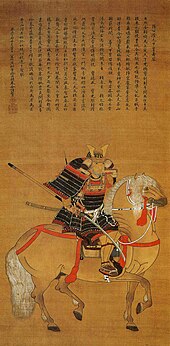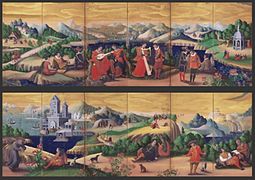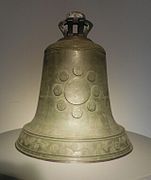Eisei Bunko

The Eisei Bunko ( Japanese 永 青 文庫 , in Tokyo Bunkyō ) houses the collection of art and objects of art of the Hosokawa clan from Kumamoto, whose head was one of the most powerful daimyō in the Edo period . The collection was brought to a foundation by Hosokawa Moritatsu ( 細 川 護 立 ; 1883–1971) in 1950 and made available to the public in an exhibition building in 1972. The museum, located on Mejiro Hill above the Edo River , stands on a corner of an old Hosokawa estate from the Edo period.
A branch museum of Eisei Bunko is located in the castle district in Kumamoto, right next to the Kumamoto Prefecture Art Hall .
overview
The tribe Hosokawa Fujitaka ( 藤 孝 , also 幽 斎 , Yūsai; 1534-1610) was not only distinguished by his military skills, but was also known as a poet writer and a scholar. His descendants expanded the collection, which includes objects from the 14th century to the present day. The name of the museum is made up of the egg of the Kennin-ji belonging in Kyoto own-an , who was a funeral temple of the family, and the Be the castle called Fujitakas, namely Seiryuji-jō.
The collection
The collection comprises 112,000 objects, including eight national treasures , 50 important cultural assets and 42 important art objects. The exhibition is changed four times a year.
National treasures
- Great sword, signed Bungo-no-kuni Yukihiro ( 銘 豊 後 国 行 平 作 )
- Short sword, probably Masamune ( 無 銘 正宗 ), 14th century
- Short sword, signed Norishige ( 銘 則 重 ), Kamakura period
- Sword, Ikoma Mitsutada ( 生 駒 光 忠 ), Kamakura period
- Saddle, oak wood with mother-of-pearl inlays
- Saddle decorated with mother-of-pearl inlays, Kamakura period
- Mirrors, gold, silver hunting scenes, China, Warring States Period
- Bowl decorated with birds and animals, China, around the birth of Christ
Important cultural assets (selection)
- Screen pair "Europeans making music" ( 洋人 奏 楽 図 , Yōjin sōgaku zu ).
- European bell with the Hosokawa coat of arms
Image selection
Attributed to Mount Fuji, Sesshu
"Cat" Hishida Shunsō , 1910
Remarks
- ↑ The property is entered on the district map "Zōshigaya-Otowa" from 1857 as an external residence ( shimo-yashiki ).
- ↑ A very similar pair of adjustable screens is in the MOA Art Museum , Atami.
Individual evidence
- ↑ Tokyo hakubutsukan kyogikai (ed.): Tokyo no hakubutsukan. 17th edition, 1989. p. 218
- ↑ The scroll painting is now in the Kumamoto Prefectural Art Museum.
literature
- Museum leaflet
- Eisei Bunko (Ed.): Eisei Bunko No. 86 . Spring 2014
Web links
Coordinates: 35 ° 42 ′ 47.4 " N , 139 ° 43 ′ 23.9" E






